
Earnshaw's theorem states that static levitation cannot be achieved with ordinary permanent magnets. But there are plenty of ways to circumvent its hypotheses:
- Active electromagnetic suspension
- Active electromagnetic levitation
- Spin-stabilized magnetic levitation (the Levitron)
- Electrodynamic suspension, including electrodynamic bearings
- Diamagnetic levitation
- Levitation and suspension of superconductors by flux pinning
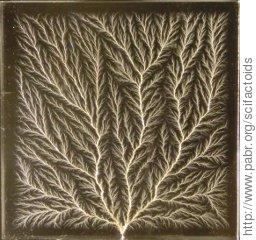
These decorative pieces are manufactured in particle accelerators. Relativistic electrons penetrate into a thick plate of Plexiglass, and a significant electrical charge accumulates at mid-depth. Breakdown occurs in the form of a brief, intense spark which leaves a permanent trace within the material.
Lichtenberg figures also appear naturally on the ground around lightning strikes and on the skin of people hit by lightning.
According to classical electromagnetism, an infinite straight wire carrying a constant current creates a tangential magnetic field, and a test charge moving at constant velocity parallel to this wire experiences a radial Lorentz force.
Now consider the frame of reference attached to the test charge. In it, the test charge still sees a constant magnetic field, but it has zero velocity. So, does it still experience a radial force ?
The modern refutation of this paradox involves special relativity, but the classical explanation from 1898 is still valid. Both analyses boil down to clarifying what it means for a conductor to be electrically neutral.
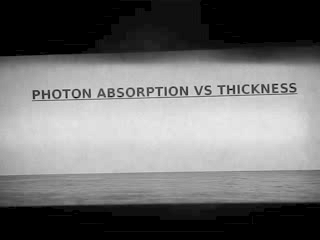
Two crossed polarizers make an opaque optical system. Insert a third polarizer at 45° between them, and the system becomes slightly transparent.
Isn't it amazing that adding more material results in less absorption ?
The principle of path reciprocity is a cornerstone of geometrical optics. It states that if a light ray travels from A to B, then a ray emitted from B in the opposite direction will travel to A.
But in electromagnetism, the principle of reciprocity must be re-stated in terms of time reversal instead of path reversal. The Faraday effect, which causes the the polarization of light to rotate in a magnetic field, makes it possible to build one-way optical devices.
Wouldn't such devices allow us to concentrate thermal radiation at no cost, hence violating the laws of thermodynamics ? No: see [MUNGAN].
Is it commonly believed that mirrors and lenses cannot be built for X-rays because no known material can reflect or refract them.
Actually, X-rays can be manipulated with a variety of optical devices such as compound refractive lenses, grazing-incidence mirrors, and even normal-incidence mirrors with special coatings.
According to a popular misconception, mirrors reverse images left-right. (Actually, the reversal is front-back.)
It can be argued that this error is caused by gravitation. Indeed, because of gravitation:
- We live in a 2D world: We walk on flat surfaces and we change directions by pivoting around a vertical axis.
- Therefore, we tend regard our reflection in the mirror as a clone of ourselves, rotated 180° around a vertical axis.
- Besides, in this 2D environment, the human body has evolved bilateral symmetry. Without this, we would have no reason to identify the reflection of our left hand with the right hand of our imaginary 180°-rotated-clone.
It is sometimes said that magenta does not exist because it is not a spectral color. Indeed, among the eight colors with all-or-nothing RGB components, magenta is the only one which cannot be produced by a source with a single-band spectrum.
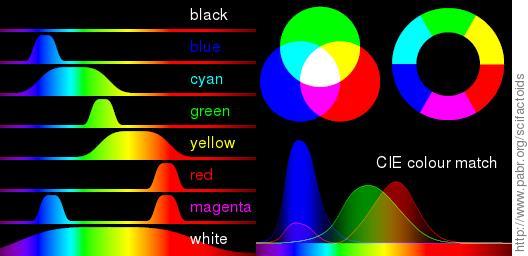
Actually, according to some models of color perception, ultraviolet radiation happens to excite not only our "S" (blue) cones, but also our "L" (red) cones, producing a bluish-magenta perception without a red component.
Rayleigh scattering explains why the daytime sky is blue. It also predicts that skylight is polarized. As a result, with suitable optical instruments, it is possible to determine the azimuth of the Sun even when it is hidden by clouds or slightly below the horizon ([SKYCOMPASS]).
This was used as a navigation aid when airplanes first ventured in the polar regions, where magnetic compasses are unreliable. The Vikings might have used the sunstone (a naturally-occurring birefringent crystal) for navigation in the open sea on cloudy days, long before the magnetic compass was introduced in Europe.
Learn how to see the polarization of the sky with the naked eye and let your hiking friends marvel at your amazing navigation abilities !
Ulexite is a naturally occurring fibrous mineral with optical properties similar to those of synthetic fiber optics. With proper polishing, a sample with parallel fibers will transmit a whole image between two opposite sides, hence the nickname "TV stone".
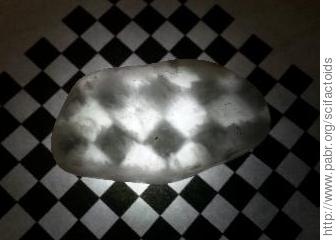
Negative absolute temperatures, which were first considered in 1956 and popularized again in 2013, occur in systems whose energy levels have not only a lower bound, but also an upper bound. They emerge naturally if we measure "hotness" with -1/kT (a prominent term in Maxwell–Boltzmann statistics) instead of T.
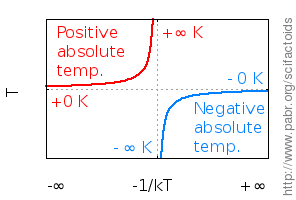
The dissolution of salt in water is exothermic. The dilution of seawater when it mixes with freshwater is exothermic as well. There are plans to extract energy from estuaries (up to 0.81 kWh/m3).
Evaporative cooling (i.e. spraying water into the air) is a very simple air conditioning technique, but it cannot cool air that is already moist.
Water spray absorption is possibly the simplest refrigeration technique that works under humid climates:
- Run the warm, moist air through a spray of salt water. This will dry it.
- Run the warm, dry air through a mist of fresh water. This will cool and re-humidify it (evaporative cooling).
- Run the cool, moist air through a second spray of salt water. Cool, dry air is obtained.
- Recycle the diluted salt water into concentrated salt water and freshwater, e.g. with a solar oven.
As a process for converting solar energy into chemical energy, photosynthesis has poor efficiency: 8 % for sugarcane, less than 2 % for most plants. State-of-the-art photovoltaic panels and electrolysers produce hydrogen with about 30 % overall efficiency.
Either evolution reached a dead end, or sunlight was not the limiting factor for plant growth (it could have been CO2, or water, or minerals instead).
The average geothermal flow is about 100 mW/m². That is 3000 times less than average solar power.
But unlike solar power, geothermal power concentrates naturally, and can therefore be exploited without sacrificing huge areas of land.
Still, the global geothermal flow only amounts to about twice our primary energy consumption.
The pressure of an ideal gas cannot drop below zero. But liquids can exhibit negative pressures due to intermolecular forces. This is the preferred explanation for the ascent of sap in trees taller than 10 m.
The tensile strength of water is estimated to be at least 20 MPa (200 bar). It drops significantly in the presence of poorly wettable surfaces or impurities, which act as nucleation sites for cavitation. For comparison, the tensile strength of pure aluminium is about 40 MPa (400 bar).
Electric fields stronger than 1.3x10^18 V/m (the Schwinger limit) can "rip the fabric of empty space" and create matter out of nothing (out of photons, actually). This was confirmed experimentally in 1997 ([SLAC_E144]). (The experiment involves a beam of electrons, but they do not take part in the photon-photon interactions. Another project will use photons only.)
Now let's invent table-top exawatt lasers and we will have the ultimate 3D printer.
It is commonly believed that each radioisotope is characterized by its half-life and that everything else about spontaneous decay is perfectly random, unpredictable and uncontrollable. This is the basis for radiocarbon dating and long-term management of nuclear waste.
Actually, there are several types of nuclear decay, and in some of them, half-lives are affected by environmental factors:
- Electron capture and internal conversion involve electrons from the lower atomic orbital. In these nuclear reactions, the chemical bonds and ionization state of the atom modify half-lives by as much as 1 %.
- In induced gamma emission, weak x-ray photons stimulate the isomeric transition (gamma decay) of a nuclear isomers.
Peeling sticky tape in the dark produces a bluish light as electrostatic charges recombine. In a vacuum, this produces enough X-rays to image the bones in a human finger ([STICKYTAPE]).
Induced gamma emission is a process similar to fluorescence, except that the nuclei of atoms, rather than their electrons, become excited. Since the analogy extends to stimulated emission and population inversion, this might lead to gamma-ray lasers someday. Another application is nuclear batteries with on-demand energy release (unlike current RTGs).
Current petawatt lasers generate electric fields of 10^12 V/m and there are plans to build exawatt lasers. This is enough to accelerate electrons to relativistic speeds ([SUPA]). Laser-driven nuclear physics is a field of research which aims to replace bulky particle accelerators with table-top lasers.
After being ridiculed throughout the whole 19th century, alchemists had their revenge in the early 20th century: We now know how to turn various metals into gold. Nuclear physicists even adopted the alchemists' terminology ("transmutation") when referring to nuclear decay.
But is there merit in being right for the wrong reasons ?
"Water expands when it solidifies. Conversely, the surface of ice must melt when mechanical pressure is applied. Hence, ice is slippery."
This explanation, although popular, is not supported by numerical models. The current theory seems to be that the interface between ice and air is inherently liquid-like ([ICE]).
Before the advent of inexpensive petrochemical-based plastics, ivory-like polymers were manufactured out of milk proteins. Nowadays, most bioplastics are synthesized from starch, which is found in potatoes and corn.
UHMWPE is the same polymer that garbage bags are made of, except that its molecules are longer (100,000+ base units). That makes it stronger than Kevlar and suitable for making military helmets, high performance ropes and fabrics, hip replacement implants, and artificial ice for skating rinks.
Aerogels are ultra-low-density solids manufactured by removing liquid from a gel in a way that does not cause capillary action to collapse its cross-linked solid structures. The well-known silica aerogels can weigh as little as 1000 g/m3 (lighter than air).
Research is currently focusing on aerographite (180 g/m3) and aerographene (160 g/m3, lighter than helium).
A hollow tube is mechanically stronger than a solid round bar of the same material and linear density. It is sometimes claimed that a hollow tube is even stronger than a solid bar of the same diameter, but I could not find a formal statement of this paradox.
In a cantilever configuration, the "dead weight" near the neutral axis of a solid bar increases its total load without contributing to stiffness. Hence, a hollow tube of the same diameter might be able to carry a heavier payload attached to the free end.
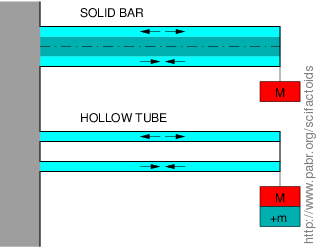
Ecospheres are artificial ecosystems comprising shrimp, bacteria and algae.
Even though the shrimp do not seem to reproduce, it is impressive that a carefully chosen mixture of living organisms can thrive for several years in a sealed container with sunlight as the only input. Larger scale experiments usually do not last that long.
The retina is the only part of the central nervous system that can be visualized non-invasively.
Blood vessels cast a shadow on your retina, but you are not aware of it because the nervous system tends to ignore constant stimuli. To see their tree-like structure, punch a pinhole in a piece of cardboard and move it at 5-10 Hz in front of your pupil while looking at a bright uniform surface.
Epigenetics refers to factors affecting gene expression which are not encoded in the DNA sequence. There are recent reports ([EPI]) that such factors can be both acquired and transmitted to several generations of offspring.
In other words, experience can be inherited - a major departure from classical genetics.
Optogenetics refers to a set of techniques which allow neurons to be controlled and monitored by light, with high spatial and temporal resolution. A related technique makes it possible to map connections between neurons.
Next we will do the same thing in the radio spectrum. It can't be long before we see non-invasive brain-computer interfaces, long-distance mind-reading/mind-control devices, and telepathy between genetically-modified humans.
Sleep research includes the study of lucid dreams, in which the dreamer is aware that he/she is dreaming. Sound signals, flashes of light and conscious eye movements allow limited communication between the dreamer and researchers (or machines). Experiments have revealed, among other things, that time passes at the same rate in the dream world and in the real world.

The Geyser pump, patented in 2007, is reportedly more energy efficient than the well-known airlift pump. It uses an accumulation chamber and an inverted siphon to release air in large bursts.

Isn't it amazing that we are still inventing such simple machines in the 21th century ?
The hydraulic ram pump is possibly the simplest mechanism for raising a portion of a watercourse without any external energy input.
Have you ever doubted the reliability of your bathroom scale and weighted yourself a second time, only to get the exact same value to three significant digits ? Maybe you considered changing the batteries then ?
- Hypothesis 1: This $20 gadget can reliably weigh up to 100 kg of pulsating flesh standing upright in unstable equilibrium, with 0.1 % accuracy (or at least 0.1 % repeatability).
- Hypothesis 2: Your scale implements hysteresis in software, i.e. it memorizes your weight (or the weights of a few users) and will keep displaying the same value until the error exceeds some threshold or some arbitrary delay has elapsed. This gives a false sense of accuracy (or at least repeatability).
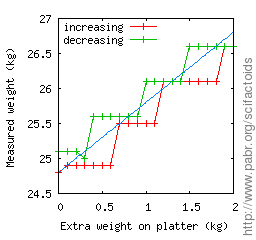
In many countries, scales intended for business transactions or medical use are legally required to have a resolution that reflects their actual accuracy. Now you know why the label on the back of your bathroom scale says "NOT LEGAL FOR TRADE" or something similar.
The Sikorsky human powered helicopter competition was won in 2013. But from an aerodynamic perspective, with 20 m wide rotors spinning only 3 m above the ground, the winning aircraft has more in common with hovercrafts than with helicopters.
As a rule of thumb, real stationary flight (out of ground effect) requires about 100 W/kg. The human body can only produce about 1200 W.
| Mass | Engine spec | Power | |
|---|---|---|---|
| (kg) | (W/kg) | (W/kg) | |
| Hummingbird | 0.006 | 100-120 | |
| Model helicopter | 0.3 | 100-200 | |
| Helicopter UAV | 7.5 | 85 | |
| Sikorsky prize winner | 128 | 6 | |
| Mosquito XE | 277 | 173 | |
| UH-60 | 9,980 | 282 | |
| Mil Mi-26 | 49,600 | 343 |
In theory power requirements are only dictated by aerodynamic drag. So, assuming further revolutions in materials science, a machine with gigantic, lightweight, extremely slow rotors might still achieve human-powered hover someday.
A vehicle with a propeller coupled to its wheels (or, hypothetically, to a water turbine) can "sail" downwind faster than the wind without tacking.
This was heavily debated in Internet forums starting in 2006. Numerous incorrect refutations still linger online, as well as incorrect proofs ! The wheels (or turbine) power the propeller, not the other way around.
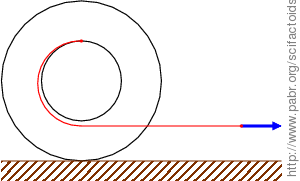
So you think computers can't be trusted ? Then stop driving, because drive-by-wire is largely implemented in modern vehicles, and here are some of the bad things that could result from software bugs or undetected spurious inputs:
- Engine control unit applies maximum throttle regardless of gas pedal position.
- Anti-lock braking system (ABS) prevents you from braking.
- Automatic transmission refuses to return to neutral.
- Engine keeps running when you press the STOP button.
- Electric power steering pivots the wheels in the direction opposite of the steering wheel.
- Electric steering lock engages while the vehicle is moving.
- Electronic stability program (ESP) suddenly applies maximum brake (only on the front left wheel, for additional fun).
- Collision avoidance system takes control of brakes and steering.
- Airbags deploy into your face for no reason.
- You have brought the car to a safe stop in the middle of the highway, but power doors refuse to unlock and power windows won't slide down.
Such incidents are remarkably rare, considering the large number of cars in circulation. It looks like the automotive industry knows how to build reliable (or at least, fail-safe) hardware/software systems.
Point an infrared thermometer at the daytime sky during a hot, cloudless summer day. You will get readings well below 0°C.
Does this simple experiment measure an actual temperature ? At least it reminds us that space radiates at 3 K (-270°C).
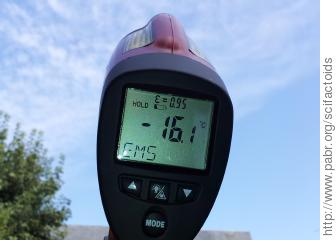
Neptune was identified as a planet by analyzing irregularities in the orbit of Uranus, rather than by direct observations. Which is a remarkable feat, considering the computational tools that were available in 1845.
Why are manhole covers round ?
Because among all curves of constant width, the circle is the shape that is easiest to manufacture and roll on the ground.
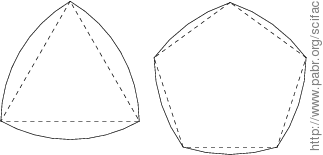
Around 300 BCE, Euclid of Alexandria proposed an axiomatic theory of plane geometry using only points, lines and circles.
It is easy to draw circles with arbitrary accuracy. But nobody really knew how to draw lines until the 19th century, when Peaucellier and Lipkin independently invented the first mechanical linkage which moves a pen in a perfect straight line.

The statement of the Collatz conjecture can be understood by primary school students. It remains unsolved.

In 1790, the French National Assembly defined the meter as the length of the seconds pendulum, whose period is 2 seconds. In the small-angle approximation the period of a pendulum of length L is 2π√(L/g); hence g was numerically equal to π².

One year later, due to objections that this definition depends on latitude and altitude, the length of the meter was adjusted (by less than 1 %) to one ten-millionth of one half-meridian.
A person with a solid mathematical education stays clear of casino games because by design, players always loose in the long term.
But a really smart person will realize that games of chance are sometimes designed by not-so-smart people, and will find ways to exploit them. There are several historical examples of martingales that actually worked. French philosopher Voltaire famously made part of his fortune by exploiting a flaw in a state lottery, with help from mathematician La Condamine.
In most mathematical theories, there are undecidable problems, i.e. statements which can be neither proved nor disproved within these theories. This means you can choose to accept them as true or false, and explore the logical consequences, with no risk of having created a contradiction.
Typed lambda-calculus is a programming language which is formally equivalent to logical reasoning. Data types (including function types) correspond to logical statements, and values (including functions) correspond to their proofs. Writing a program is the same as proving that its specification is sound.
Unfortunately most real-world programming languages allow null/nil pointers/references, whose logical counterparts are paradoxes. "He who gives up elegance for convenience deserves neither."

Bayes' theorem provides radical (though controversial) arguments to end certain debates. Here are a few applications.
Anthropic principle in cosmology: There is an extremely small probability that a random planet in a universe with random cosmological constants would sustain human life. Therefore, shouldn't we marvel that the Earth and mankind exist at all ? Bayesian counter-argument: This is not surprising, because if no planet could sustain life, we would not be here to marvel about anything.
Survivorship bias in evolution: Nature is beautiful. Doesn't this imply that it was somehow designed for us ? Bayesian counter-argument: If our species did not enjoy a blue sky and green grass, it would have gone extinct a long time ago.
The set of useful real numbers is countable.
"Proof": The only useful real numbers are those that exist beyond reasonable doubt, i.e. the computable reals, plus Omega, plus the busy beaver scores, plus maybe a few (presumably countable) other made-up monstrosities.
[SLAC_E144] SLAC Experiment 144 Home Page . http://www.slac.stanford.edu/exp/e144/e144.html.
[MUNGAN] Faraday Isolators and Kirchhoff’s Law: A Puzzle . http://usna.edu/Users/physics/mungan/_files/documents/Scholarship/FaradayIsolators.pdf.
[SKYCOMPASS] A Sky Compass for Field Use. http://www.vetmed.wsu.edu/org_nws/NWSci journal articles/1950-1959/1954 vol 28/v28 p43 Campbell.PDF.
[STICKYTAPE] Sticky tape generates X-rays . http://www.nature.com/news/2008/012345/full/news.2008.1185.html.
[ICE] Why Is Ice Slippery ? . http://lptms.u-psud.fr/membres/trizac/Ens/L3FIP/Ice.pdf.
[SUPA] Laser-driven particle and photon beams and some applications . http://iopscience.iop.org/1367-2630/12/4/045005/fulltext/.
[EPI] Fearful Memories Passed Down to Mouse Descendants . http://www.scientificamerican.com/article.cfm?id=fearful-memories-passed-down.











































